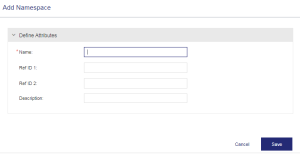Namespaces
|
New to Sentinel EMS?
|
What is a Namespace?
The creation and use of namespaces differs according to the enforcement.
|
|
|
|
|
A namespace represents the Batch Code created at the backend when the batch code is introduced. In Sentinel EMS, a namespace also acts as a workspace, differentiating between separate storage locations
|
A product can include only the features
Entitlements transcend namespaces and can contain products

 Prerequisites for Creating a Namespace
Prerequisites for Creating a Namespace
Only users with administrative rights can create namespaces.

 Creating a Namespace
Creating a Namespace
You create a namespace from the Namespaces page.
To create a namespace:
1.From the navigation pane, select Catalog > Namespaces to view the Namespaces page.
2.Click the Add Namespace button.
3.Fill in the namespace attributes.
4.After the namespace is saved, specify permissions for the namespace users as needed. For more information, see Users and Roles.

 Namespace Attributes
Namespace Attributes
The following table explains the namespace attributes:
| Attributes | Description | Required/Optional | Valid Values |
|---|---|---|---|
| Name | Name of the namespace. The validity of the namespace name depends on the enforcement in use. | Required |
>Must be unique >Alphanumeric >1 to 200 characters |
| Ref ID 1 | Reference identifier that identifies the namespace in an external system. | Optional |
>Alphanumeric >0 to 100 characters |
| Ref ID 2 | Reference identifier that identifies the namespace in an external system. | Optional |
>Alphanumeric >0 to 100 characters |
| Description | Additional information about the namespace. | Optional |
>Alphanumeric >0 to 500 characters |

 Actions for Namespaces
Actions for Namespaces
The following table lists the actions available for namespaces:
| Action | Description | ||
|---|---|---|---|
|
Updates existing namespace information. See Editing an Entity to understand how to edit an entity. Note: You can modify all attributes irrespective of the deployment status of a namespace. A namespace is considered "deployed" when it is used in an entitlement. |
||
|
Deletes the namespace. See Deleting an Entity to understand how to delete a namespace. Note: >You cannot delete deployed namespaces. >Deleting a namespace also deletes all of its associated features and products upon confirmation. |

